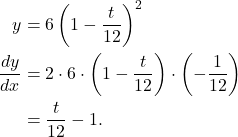Problem 154: It takes 12 hours to drain a storage tank by opening the valve at the bottom. The depth ![]() of fluid in the tank
of fluid in the tank ![]() hours after the valve is opened is given by the formula
hours after the valve is opened is given by the formula
(1) ![]()
a. Find the rate ![]() (m/h) at which the tank is draining at time
(m/h) at which the tank is draining at time ![]() .
.
b. When is the fluid level in the tank falling fastest? Slowest? What are the values of ![]() at these times?
at these times?
Solution:
a. By the chain rule,
(2) 
That is, the tank is draining at a rate of
(3) ![]()
b. When ![]() ,
, ![]() (m/h), and when
(m/h), and when ![]() ,
, ![]() (m/h). Therefore, the smallest value is at t = 0 h and the largest at t = 12 h.
(m/h). Therefore, the smallest value is at t = 0 h and the largest at t = 12 h.

Leave a Reply